Yes! I'd like to be contacted to schedule a consultation!
Are you a busy general contractor overwhelmed by the ever-changing world of online marketing? You're not alone.
Today, attracting new clients often hinges on where you land in search engine results. However, for busy contractors, navigating the complexities of search engine optimization (SEO) can feel like a daunting task that takes them away from the job site and their clients.
This comprehensive guide is here to change that. We'll break down SEO into easy-to-understand steps specifically tailored for general contractors.
Forget about frustrating marketing jargon. Here, you'll find actionable strategies you can implement to build a robust online presence that supports your business's future.
Table of Contents
These days, most people in North America turn to search engines like Google to find the services they need. Over 86% of consumers go on Google as the first step in finding a local business.
When someone searches for “kitchen renovation” or “bathroom remodel”, you want your contracting company to be the first result they see. Studies show that around 28% of clicks go to the first result that pops up organically (meaning it wasn’t a paid ad) on Google’s search results page.
That’s where SEO comes in.
SEO is the practice of optimizing your website and online presence to appear higher on search engine results pages (or SERPs for short) for relevant keywords typed in by searchers. In simpler terms, it’s about ensuring potential customers can easily find your contracting business online when searching for your services.
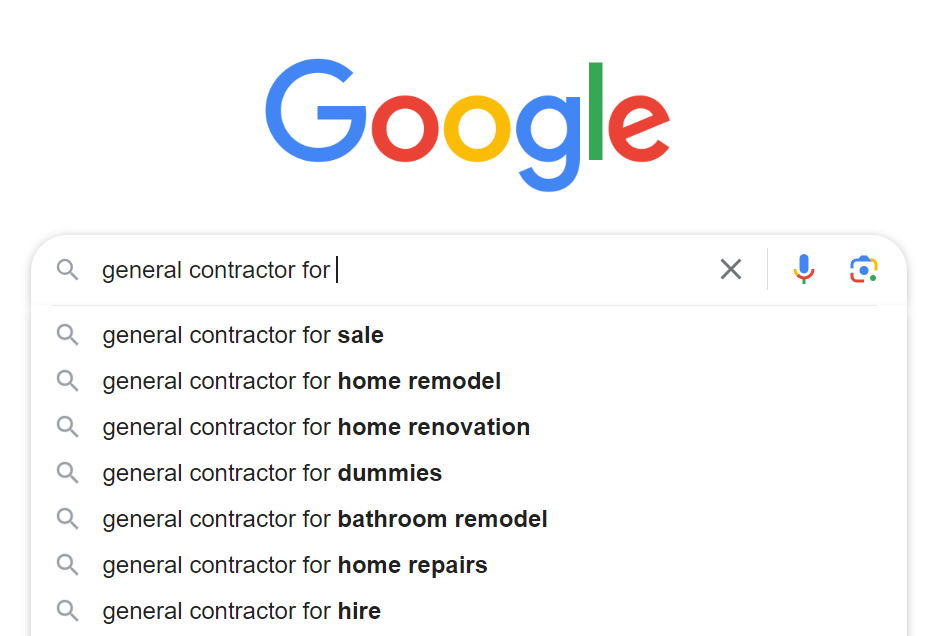
SEO is about making sure your business appears when people search for a general contractor.
Here’s why SEO is so crucial for general contractors:
Investing in SEO is an investment in the future of your contracting business. It’s an ongoing process that delivers consistent results, helping you attract new clients and grow your business over time.
Here at LinkNow, we’ve helped our clients rank in the number-one position on Google for over 140,000 keywords and generated over 698,000 verified leads. These results help our small business clients grow their revenue with minimal time and cost investment on their end, demonstrating the immense benefits of SEO.
We’ve covered why SEO is crucial for general contractors, but what are some reasons it can be additionally beneficial to your business?
SEO can help small contracting teams grow in these ways:
Have you ever typed a question into Google and wondered how the search engine sorts through billions of web pages to deliver those perfect results in a fraction of a second? The answer lies in Google’s sophisticated search algorithms and the tireless work of search engine crawlers.
Google’s crawlers are bots that work like digital librarians, constantly scouring the internet, ‘reading’ new web pages, and indexing them (basically saving a version of them) in Google’s massive database. According to some estimates, over 400 billion pages are currently indexed.
Once a web page is indexed, Google’s complex algorithms analyze it using a secret formula of ranking factors to determine its relevance and usefulness for specific search queries.
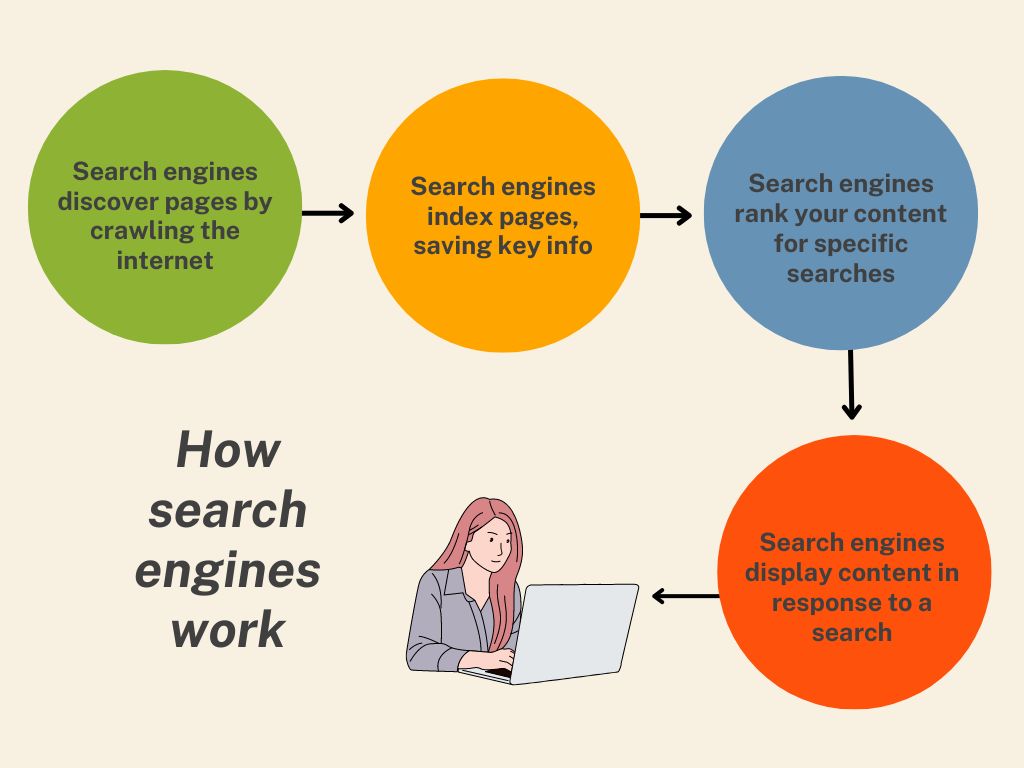
Your content is crawled, indexed, ranked and displayed by search engines.
Google’s exact ranking algorithm has always remained a secret. However, SEO experts have made educated guesses based on the information Google does release, as well as trial and error, to identify several key factors that significantly impact where your general contractor website lands in search results.
Here’s a breakdown of the most important ranking factors that might affect your site:
The rest of this guide will go into more detail on each of these key ranking factors, helping you improve your website’s search engine visibility and attract a steady stream of qualified leads for your general contracting business.
Imagine your website as a blueprint for building a home.
A well-designed home will make the most of available space, encourage a logical flow and layout, and allow occupants to move easily throughout the structure. Similarly, a website optimized for search engines allows readers to navigate through pages easily, find what they need, and enjoy their experience browsing.
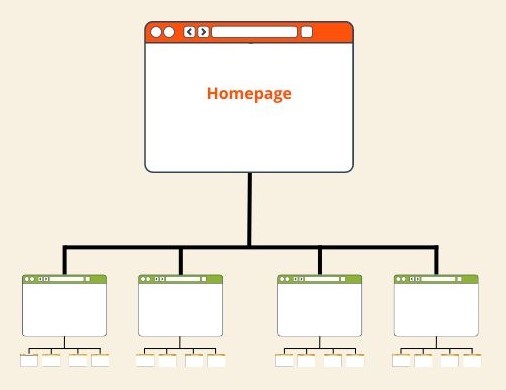
A well-designed site has an easily navigated site architecture with a pyramid-like structure.
This section dives into the world of on-page SEO and the essential practices you can implement directly on your website to improve its navigability and clarity. The better Google and other search engines understand your website, the higher the chance it will be displayed for searches related to your contracting services.
Within on-page SEO, three key elements play a crucial role in how search engines understand and rank your website: titles, meta descriptions, and header tags. Let’s explore how to optimize each for maximum impact:
Your title tag is part of your website’s HTML code. It looks like this:
<title>The Ultimate Guide to SEO for General Contractors</title>
This piece of code gives your website a headline that shows up at the top of your page. This is also the text that shows up on the SERP that people click on to get to your website, and it appears in the browser tab.

A clear and simple title specified in a title tag is essential for an easily-found website.
Your title tag should be clear and concise (ideally under 60 characters) and incorporate your target keyword naturally. Think of it as your first impression on potential clients in search results.
The meta description is a brief blurb displayed under your title tag in search results. The meta is your chance to entice users to click on your link on a SERP. Craft a compelling description (around 155 characters) that summarizes your web page’s content, highlights its value proposition, and includes a call to action.

Your meta description should compel searchers to click on your result.
Header tags are similar to title tags, in that they are also HTML elements. However, you can (and should) have more than one header tag on your web page, and there are different kinds: h1s, h2s, h3s, etc., up to h6.
They look like this: <h4>What are header tags?</h4>
The purpose of header tags is to structure your content and make it easier for users to scan and navigate. Think of them as subheadings within your content. While search engines do consider header tags for relevance, their primary purpose is to enhance user experience.

On this page for general construction services, the h2 (Our Approach to General Construction) and h3 headers help to break up content and keep the flow of the page intact.
Websites with informative, relevant content consistently do better than those without it.
According to BKAContent, websites with active blogs have 434% more indexed pages and 97% more inbound links than those that don’t. DemandMetric also says that companies with active blogs see 67% more leads generated than those without.
Why is this? Because Google prioritizes websites that offer informative and valuable content relevant to user search intent. Once that content ranks highly, searchers read it and gain trust for the company that wrote it, leading to conversions and revenue.
Every LinkNow website sold comes with industry-specific, keyword-optimized content because we understand the irreplaceable value of high-quality content.
So, how do you write high-ranking content? The first step is to understand your target audience’s search intent through something we in the biz call “keyword research”.
Use keyword planning tools like Ubersuggest, Google Keyword Planner, and AnswerThePublic to find the terms for which your target audience is searching. Look for search terms with high traffic (lots of people are searching for them) but low competition (not many other websites contain them).
Then, incorporate these terms into your content, being careful to use them naturally without stuffing them into your writing wherever possible.
Some tips for doing keyword research specifically for general contractors:
You’ve put your blood, sweat, and tears into building up your knowledge about contracting—here’s your chance to share it with an audience that’s ready and willing to hear it.
Informative content positions you as a leader in the construction industry. Share your past projects, discuss the average project completion time, offer expert tips on common renovation challenges, or answer frequently asked questions in a dedicated FAQ section.
Read more about content marketing strategies for contractors.
The vast majority of people these days use their phones to browse the web. This means that a website that isn’t mobile-friendly is practically invisible.

A responsive design ensures your content adjusts to the screen size it’s viewed on.
Here’s what it means to be mobile-friendly:
By following these steps, you’ll create a mobile-friendly website that offers a seamless user experience and keeps potential clients engaged, no matter how they browse.
Picture your website as the best-laid-out utility room in the world. You’d have a logical layout with each utility’s infrastructure clearly labeled and organized in its own space. Rather than pipes and wires crisscrossing in every direction, you’d have visible, accessible pathways that ran as straight as possible without unnecessary twists or turns.
On your website, you build these straight pathways with clear labels through “internal linking”. Every page of your website should be connected to others through a well-thought-out web of links that make it easy to jump to the page you’re interested in reading.
We recommend drawing out a diagram of your website (or a sitemap) before building it. You can even just take out a pen and paper and sketch your site structure, indicating which pages will link to which for easy navigation.

Using breadcrumb links (links at the top of the page referring to pages previously visited) is a good way to make your internal linking easily navigable.
In general, make sure the main menu is easily accessible at the top of every page and that links to any other relevant pages are included throughout the text.
For example, imagine your page on “renovation services” mentions the permitting process, and you have a blog post on acquiring permits. You’d likely want to link to the blog post within the text of your renovation services page.
Follow these tips to make your website easy to navigate, helping users connect with your company:

Technical SEO is pivotal in ensuring your website is easily discoverable, crawlable, and indexable by search engines like Google. By implementing the right technical SEO strategies, you can improve your website’s visibility and user experience and, ultimately, attract more qualified leads.
Search engines prioritize well-structured, fast-loading, and mobile-friendly websites, making technical SEO an essential component of your overall SEO strategy.
This section will delve into the key technical SEO elements that every general contractor should prioritize. From optimizing website architecture and site speed to ensuring mobile-friendliness and implementing structured data, we’ll explore practical techniques to help you lay a solid foundation for your online success.
Website speed is a critical factor that can make or break a user’s experience. Slow-loading websites not only frustrate visitors but also negatively impact search engine rankings.
The ideal loading speed for a website is under two seconds. Speeding up your website is something your web designer will likely deal with as it’s highly technical. However, here are some of the simpler and effective strategies to optimize your website’s speed that you may want to discuss with them:
Every time a user visits your website, their browser sends multiple HTTP requests to retrieve various elements like images, stylesheets, and scripts. Reducing the number of these requests can significantly improve page load times.
Techniques like image optimization, CSS and JavaScript minification, and leveraging browser caching can help minimize HTTP requests.
Large, unoptimized images and media files can significantly slow down your website. Compressing and resizing images, using appropriate file formats, and implementing lazy loading can dramatically reduce page weight and improve load times.
Browser caching allows visitors’ browsers to store certain website resources locally, reducing the need to download them repeatedly on subsequent visits. Implementing proper caching can significantly improve page load times for returning visitors.
Structured data markup, or schema markup, is a system of HTML annotations that help search engines understand your website’s content and pull data to display directly on the SERP. Structured data markup plays a pivotal role in enhancing the presentation of your website’s content in search results and can improve click-through rates.
By marking up elements on your page, you provide search engines with additional context and metadata about your website’s content, enabling them to display rich snippets, knowledge panels, and other enhanced search features.
A rich snippet, also known as a rich result, is an enhanced search result that displays additional information beyond the standard title, URL, and meta description.
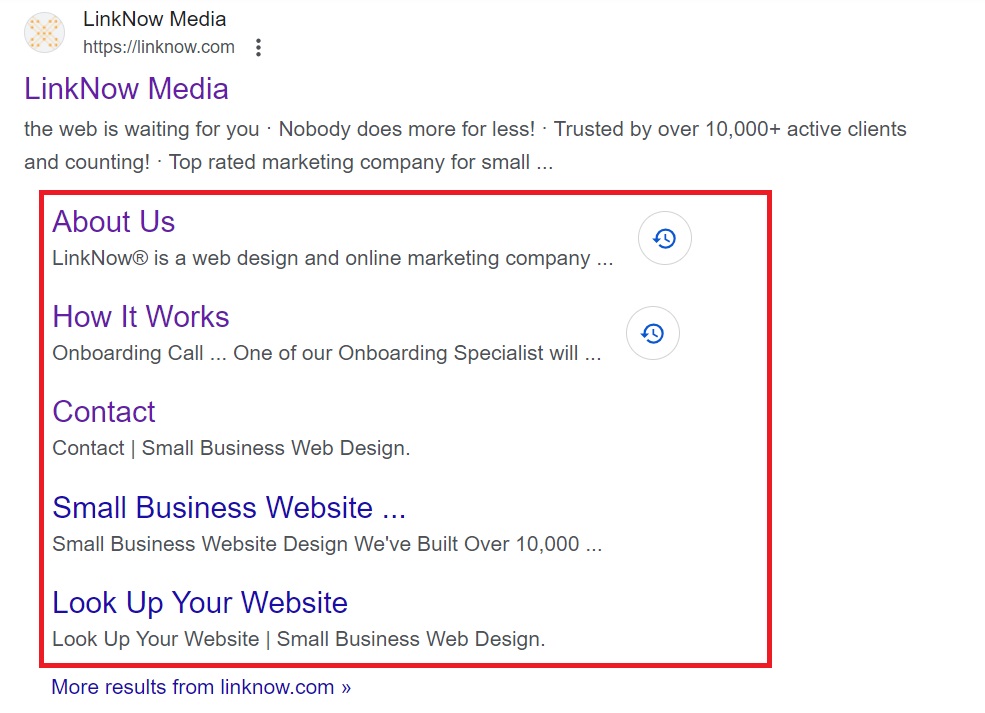
Using structured data markup enables search engines to pull extra information from your site and present it on the SERP.
A knowledge panel is an information box that appears on Google when you search for people, places, organizations, or things. These panels give you a concise overview of what you searched for without having to visit multiple websites.

A knowledge panel is an area of the SERP where a definition of the searched for entity is presented without the searcher having to visit another webpage.
A featured snippet is a specially formatted search result designed to directly answer your question right at the top of the SERP. This snippet is pulled from a web page and typically includes a summary of the answer extracted from the content of the page.
having to visit multiple websites.
A featured snippet boosts an informational section to the top of the SERP.
Not securing your website with HTTPS can hurt your website ranking and users’ trust in your website’s legitimacy.
All LinkNow websites are HTTPS-secured because we know the importance of this step.
In case your website designer hasn’t done so, follow these steps to secure your website:
On-page SEO optimizes your website for search engines, but off-page SEO takes things a step further by reaching out to other websites and building a web of influence that bolsters your site’s authority and ranking.
Off-page SEO is a long-term investment that takes time to pay off, but it’s a worthwhile endeavor for your future stability. In this section, we’ll explore strategies to build your online reputation and establish your general contracting business as a trusted authority in your community.
By leveraging social media engagement, backlinking strategies, and guest blogging, you’ll increase your website’s visibility and attract more qualified leads ready to turn their dream renovation into a reality.
Backlinks are instances of other websites that include a link to your website. Think of backlinks as recommendations from other websites pointing back to yours, telling search engines and users that your website is trustworthy.
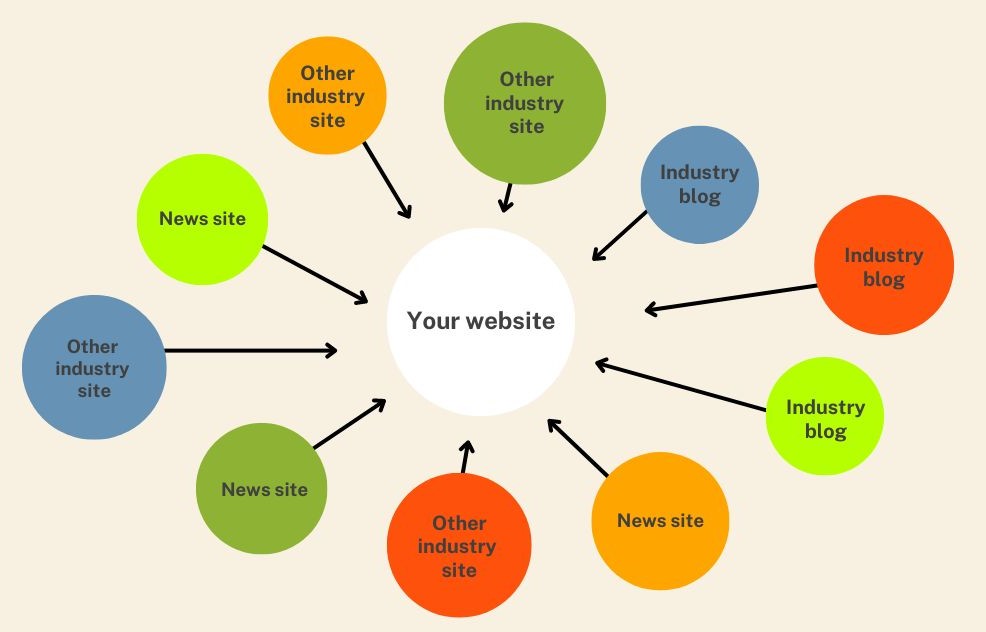
Backlinks from other sites, such as industry sites, other blogs, and news sites add authority to your website.
Search engines like Google consider backlinks a sign of trust and credibility. The more high-quality backlinks you have from relevant websites in the construction industry, the more likely your website will rank higher in search results.
It’s very important to note that a few high-quality backlinks (links from high-authority domains) are far more valuable from an SEO perspective than many low-quality backlinks (links from domains with low authority).
There are a few main ways websites gain backlinks:
Guest blogging is exactly what it sounds like: you write a post that goes on someone else’s blog, like being a guest on a radio show. In exchange for your expertise, you can usually include a link back to your website in your author bio.

Guest blogging is an excellent way to gain referral traffic and boost your website’s authority.
When building up the reputation of your general contractor website, you can take advantage of the numerous opportunities to guest blog. Reach out to local publications, construction blogs, or even neighborhood association websites. Offer to write informative articles about home improvement tips, common renovation challenges, or safety considerations during construction projects.
While social media platforms themselves don’t directly influence search engine rankings, they can be powerful tools to enhance your off-page SEO efforts for your general contractor website.
While it’s difficult to at first see the SEO value of social media, we’ve found that our clients who use our social media management services see returns.
Here’s how social media can benefit your business:
While standard SEO helps your general contracting business rank well for relevant searches nationwide, local SEO takes a strategic laser focus on your city or region.
Local SEO is all about showing up on Google when someone searches for “kitchen remodel expert near me” or “bathroom tiling in [city name]”. This can take the form of appearing in the Local Pack on Google Maps or the organic search results for location-specific searches.
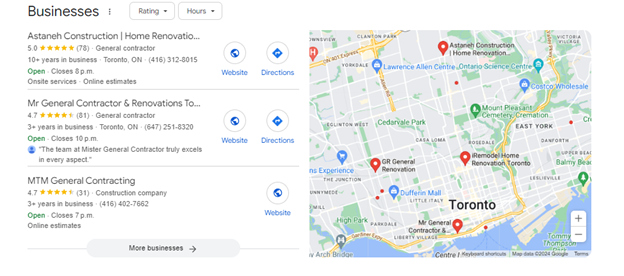
Local SEO aims to help your business appear on Google when someone searches for a general contractor near you.
In this section, we’ll go into how to make sure you’re the top local result when someone nearby searches for your services.
A robust local presence is crucial for any general contractor, and a key element is claiming your free Google Business Profile. This profile acts like a digital storefront on Google Search and Maps, showcasing your business to potential clients searching for local contractors.
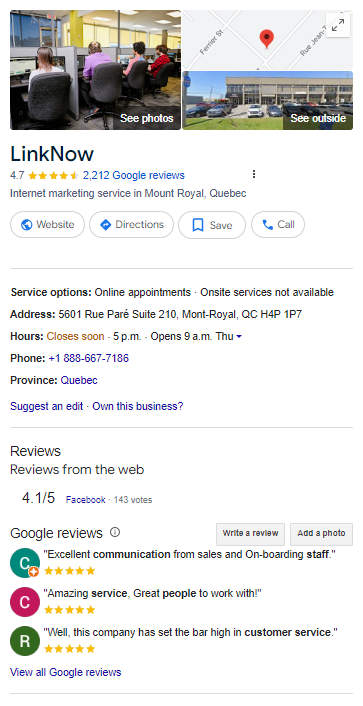
A free Google Business Profile is your first step to making sure local clients can find your business.
Here’s how to get started:
Online citations are listings of your business information—name, address, and phone number (NAP)—in various online directories, websites, and platforms. These citations act like digital endorsements, telling search engines that your business is legitimate and relevant.
The more consistent and numerous your citations are across the web, the stronger your local SEO becomes. This can be time-consuming and tedious, but you can seek out professional citation management services to do it for you.
Your Google Business Profile is your most important citation, but many others are worth pursuing. For general contractors, some of the most impactful citations are:
Building as many online citations as possible is important, but equally as important is ensuring your NAP is the same in every citation. We recommend regularly auditing your citations to make sure no inaccurate information has made its way into your online listings.
Here at LinkNow, we’ve partnered with Yext, an industry-leading citation management tool, to streamline our client’s citations, audit them for inaccuracies, and seek out opportunities for new listings. Our partnership means we’re able to offer a fully hands-off citation management service, enabling our clients to have us do all the work for a lower cost than signing up for the tool themselves.
Online reviews can significantly impact your SEO efforts and overall online visibility. Positive reviews not only boost your credibility and trustworthiness but also act as a ranking factor for search engines like Google.
Here are some effective strategies to encourage online reviews from your clients:
Learn more about how to generate reviews from satisfied clients.
Understanding how to measure SEO success and analyze website analytics is essential for refining your strategies and achieving better results over time. This section will guide you through key metrics to track, tools to use, and how to interpret the data to make informed decisions.

Measuring the performance of your SEO efforts includes analyzing website traffic, user behavior, conversion rates, and other indicators of engagement and return on investment. We’ll explore various tools and techniques to help you gather and analyze this data effectively.
We’ll discuss setting realistic goals and benchmarks and making data-driven decisions to enhance your online presence and attract more potential clients.
These are the key metrics you’ll need to track to understand how well your SEO efforts are working:
Organic traffic refers to the number of visitors coming to your website from a search engine result, not paid advertisements.
This is a primary indicator of SEO success as it shows how well your site attracts visitors naturally through search engines. An increase in organic traffic generally suggests that your SEO efforts are improving your site’s visibility and relevance.
Keyword rankings refer to the positions that your website holds in the SERPs for specific keywords.
Tracking where your website ranks for specific keywords helps you understand how visible your site is for critical searches that relate to your business.
Your CTR is the percentage of users who click on your website’s link after seeing your listing in the search results. CTR helps assess the effectiveness of your title tags and meta descriptions in enticing users to visit your website.
Bounce rate is the percentage of visitors who navigate away from your site after viewing only one page.
A high bounce rate might indicate that your site’s content isn’t relevant to what the visitors were expecting to find, or the user experience might be lacking.
Conversion rate is the percentage of website visitors who complete a desired action, such as filling out a contact form, signing up for a newsletter, or making a purchase. This metric helps measure the ultimate effectiveness of your website and SEO efforts in achieving your business objectives.
There are many SEO analytics tools available. They offer various features that give you in-depth insights into your SEO performance, come at varying price points, and have varying ease of use. We won’t go into them all—you can research and compare at your leisure.
Instead, we’re going to just point to two basic tools that can help you monitor the five metrics discussed above:
Google Analytics is a comprehensive tool that can help you monitor organic traffic, bounce rate, and conversion rates. It provides a deep dive into how users interact with your website, where your traffic comes from, and how effectively you’re converting visitors into customers.
Google Search Console focuses on your site’s visibility in Google SERPs. It helps track your keyword rankings, CTR from search results, and identifies issues that might affect your search performance.
SEO doesn’t show results overnight. It takes time and constant effort to climb the ranks of Google’s SERP.
Here’s how you can set realistic goals for your SEO efforts so you don’t get discouraged and can strive toward that day when you realize you’ve succeeded:
Before setting any goals, you need to clearly understand your current metrics. Install and set up tracking tools like Google Analytics and Google Search Console to track your website’s data.
Then, conduct an initial audit: Look at your current organic traffic, keyword rankings, CTR, bounce rates, and conversion rates. This provides a baseline from which you can measure growth.
S.M.A.R.T. goals are specific, measurable, achievable, relevant, and time-bound. Here’s what that might look like:
Once you have your goals, develop strategies based on data-driven insights.
If your goal is to increase traffic, identify which pages are currently performing well and expand on that content. Also, use keyword research tools to find new, relevant keywords to target.
If you want to rank higher, focus on optimizing your content and on-page SEO elements (like meta tags, headers, and images) for the keywords for which you want to improve your rankings. Consider building quality backlinks to boost these rankings.
If improving CTR is a goal, experiment with different meta descriptions and title tags to make them more appealing in SERPs.
If you want to lower your bounce rate, analyze the pages with high bounce rates to understand potential causes—poor content quality, misleading title tags, and meta descriptions, or poor page design.
If you want to boost your conversion rates, look at the user paths that lead to conversions and strengthen those pathways while also testing different calls-to-action and page layouts to see what converts best.
Put your plans into action. This might include rewriting content, redesigning certain pages, or enhancing your site’s mobile usability. Regularly check your analytics to see how the changes affect your metrics.
If you’re not seeing the expected improvements, it’s important to tweak your strategies. SEO is iterative, and continuous improvement is part of the process.
Keep detailed records of your SEO efforts and their results. Reporting helps you see what’s working and what isn’t.
Use the insights gained to refine your approach continually. SEO trends and algorithms change frequently, so staying adaptable is key.
LinkNow’s motto is “we make small business life easier”, and that extends to reporting. We provide our clients with the info they need to understand where they’re ranking and how their SEO investment is doing.
This removes a lot of the headache for our clients who are busy contractors and want to spend as much time as possible overseeing their projects and meeting with their clients.
Content marketing is a strategic marketing approach focused on creating and distributing content—written, photographed, filmed, etc.—to attract and retain a clearly defined audience of potential clients.
Content marketing allows general contractors to attract and engage prospective clients cost-effectively by creating various valuable content assets like blog articles, videos, guides, and social media posts. Unlike traditional advertising, which can be expensive, developing this content requires a relatively low investment. However, these content pieces can be incredibly powerful for showcasing expertise and building trust with your target audience.

In this section, we’ll go over content marketing strategies and the types of content most suited to general contractors.
Before you start creating content, take some time to understand who your audience is and what they’re looking for. Consider the types of projects your potential clients might be interested in, such as home renovations, new constructions, or commercial projects.
Use this information to tailor your content to answer their questions, address their concerns, and showcase your expertise in those areas, using educational blog articles, comprehensive project stories, step-by-step guides, FAQs, and more.
Regular posting is key to maintaining blog visibility and engagement. Aim for a consistent schedule that balances quality and quantity. For most general contractors, posting one to two articles per week is a good start.
The ideal length of blog posts varies depending on the topic’s complexity and the depth of information required. Generally, articles should be at least 500-700 words to cover a topic sufficiently. For more detailed discussions, such as step-by-step guides or deep dives into specific aspects of construction, aim for 1,000 to 2,000 words.
Start with these types of articles on your blog:
Creating videos, on top of everything else, might seem daunting. But remember, as a general contractor, most of the video production is already done for you. Your everyday work is highly filmable—you just need to get in the habit of pulling out your phone and hitting record.
Here are some video ideas to get you started:
What do you do with video content once you have it? Add your videos to a relevant page on your website, either a blog article or a service page. You can also share them via your social media platforms.
Everything we just talked about sounds like a lot of work—and it is. Making content takes time and energy, which few general contractors have to spare.
That’s why we suggest a strategy that avoids creating additional content for your social media pages and instead focuses on reusing the content you already made for your website.
Here are two examples:
When you create a new blog post, share it on your Facebook page multiple times, highlighting a different aspect each time. This gets more people clicking on your blog and going to your website, but it also populates your Facebook page with already-made content.
Whenever you make a video for your website or blog, share it on Instagram and TikTok, two platforms that reward high-quality videos and photos. You can even break up your videos into multiple parts, encouraging people to follow your page for updates.
Compared to paid advertising, the advantages of content marketing are cost-effectiveness, long-term benefits, and strong customer relationships. Once created, content can continue to attract clients over time without ongoing costs while building brand authority and online presence gradually but sustainably.
However, content marketing is time-intensive and brings slower results than paid advertising.
Paid advertising involves paying to display ads in various formats (like pay-per-click, social media ads, or banner ads) directly targeting potential clients. The goal is to generate immediate visibility and quick conversions.
The benefits of paid advertising include immediate visibility, targeting capabilities, and scalability. Paid advertising can quickly generate traffic and leads while allowing you to target specific demographics, locations, and behaviors. Paid campaigns can also be scaled up or down based on budget and performance, providing flexibility in marketing spend.
However, paid advertising requires ongoing investment. Reliance on paid advertising can also make a business vulnerable to changes in advertising costs and platform algorithms.
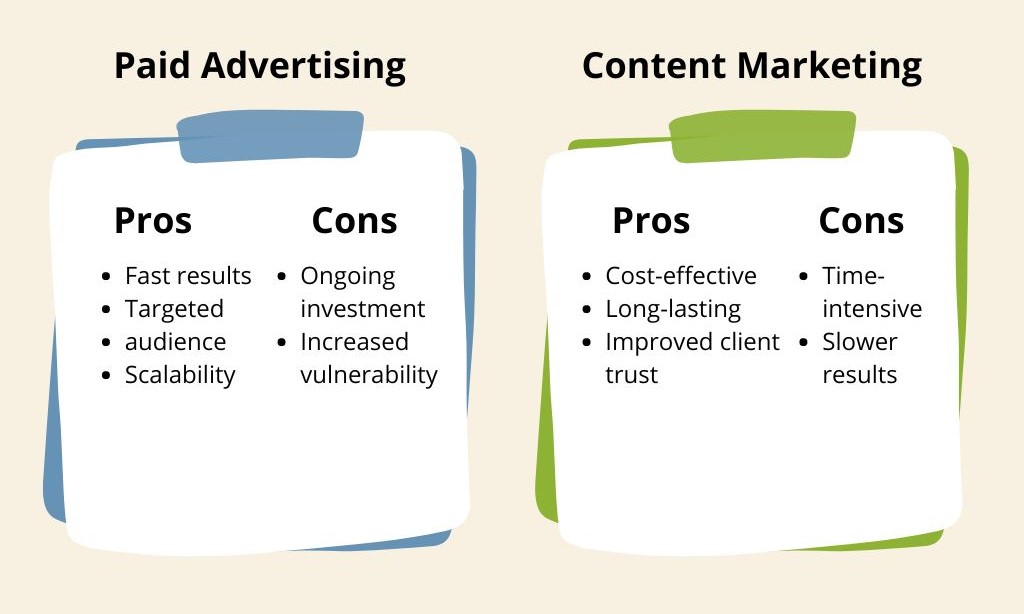
Neither paid advertising nor content marketing are perfect solutions. Both offer combinations of pros and cons.
Ideally, contractors should consider integrating both strategies. For instance, paid advertising can drive traffic to content-rich landing pages that help convert visitors into leads. Content marketing efforts can also support and enhance the effectiveness of paid advertising by warming up leads that are then retargeted through paid campaigns.
Here at LinkNow, we offer both organic content marketing services, as well as paid advertising management services. With the combination of the two strategies, we’ve helped generate thousands of leads for our clients.
This section goes into the most common SEO pitfalls that websites for general contractors encounter. We’ll provide clear, actionable advice on how to avoid these mistakes, ensuring your SEO strategy is as strong and effective as possible.
From overlooking local SEO to neglecting mobile optimization, learn how to sidestep these common errors and boost your digital footprint in the competitive construction industry.
Keyword stuffing is an outdated SEO technique that involves overloading a web page’s content with the same target keywords in an attempt to manipulate a site’s ranking. This practice makes the text difficult to read and unnatural, detracting from the user experience.
Here’s why you should avoid it:
Most construction services are local in nature. A proactive local SEO strategy makes it more likely your business will appear prominently in the search results when potential clients search for services like yours nearby.
This enhanced visibility is particularly evident in Google’s prioritization of local businesses for queries with local intent, such as “general contractors near me”.
A well-maintained Google Business Profile can significantly increase your visibility. It enables your business to show up in local search results and on Google Maps, making it easier for potential clients to find your contact details, directions, and operating hours.
Being present and active in online directories like Yelp and Angi also boosts your online presence and lends credibility, which is crucial for attracting more clients.
First impressions matter. According to research by Stanford University, 75% of users make judgments about a company’s credibility based on its website design. This makes it clear that professional and modern website design is essential to conveying trust and credibility, which are essential qualities in the competitive construction industry.
Websites that are easy to navigate, load quickly, and are mobile-friendly tend to perform better in search rankings. Mobile devices account for approximately half of web traffic globally, underscoring the importance of responsive design. Meanwhile, a Google study found that a one-second delay in mobile load times can impact conversion rates by up to 20%.
Features like secure browsing and clear contact information are also critical for building trust. Since 2014, Google has considered HTTPS encryption a ranking factor, penalizing websites that aren’t secured.
The hard way to avoid making these SEO mistakes is to become an SEO expert, technical web designer, content writer, video creator, graphic designer, and data scientist.
The easy way is to outsource this work to a company that can do it efficiently and for a lower cost. This is what many businesses do, and we should know. LinkNow is a Canada-based web design and online marketing company that specifically tailors its SEO services to small- and medium-sized businesses.
We provide every service you need to get your website online and on Google’s radar, including:
Many of our clients are general contractors who can’t spare the time and resources to master the world of SEO themselves. Instead, they outsource this expertise and effort to us for an affordable monthly cost.
You’ve made it all the way here, so we assume you’re interested in boosting your online presence. Now, you have a choice to make: DIY SEO or hiring a professional SEO company.

Doing your SEO yourself might be more cost-effective, but it’s generally very time-consuming and can draw attention away from other priorities. SEO requires a significant time investment, especially to learn and then implement the strategies effectively. This can be challenging if you’re also managing the day-to-day operations of your business.
Also, without extensive SEO experience, it may take longer to see results, and there’s a risk of making errors that could negatively impact your site’s ranking.
When you hire an SEO company, they bring a wealth of knowledge and experience. They stay up-to-date with the latest trends and algorithm changes, which can lead to more effective and quicker results.
Outsourcing your SEO lets you focus on other aspects of your business while professionals handle your online visibility. They’ll continuously monitor your website’s performance and can rapidly adjust strategies as needed, which is crucial in the fast-paced digital environment.
SEO is an unavoidable necessity for general contractors who want to get noticed online and bring in more business, but it doesn’t have to be a burden. By using smart SEO strategies designed for the construction industry, you can boost your site’s ranking on search engines, making it easier for potential customers to find you.
But this process is about more than just appearing in search results—it’s about building a solid online presence that earns trust and beats the competition. Any way you look at it, investing in SEO is a smart move for your business’s future growth and viability.
Are you eager to know how all this info applies to your business? The good news is that you can speak directly with a LinkNow expert who’ll discuss your current website, competition, and ranking and tell you what to do next.
Whether you already have a site or need one built, we can take you from online obscurity to visibility—fast. Book a free call with a LinkNow rep to go over your website’s current ranking, your ranking potential, and how you can fulfill it.